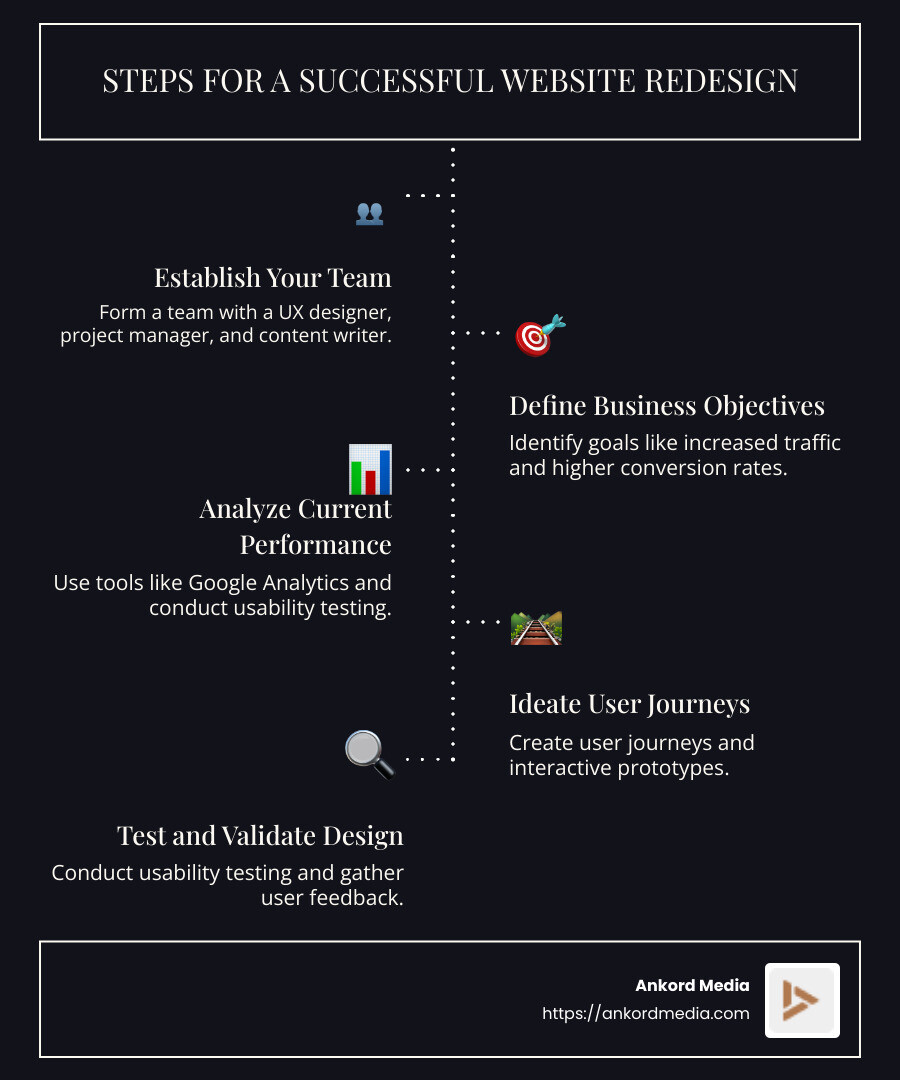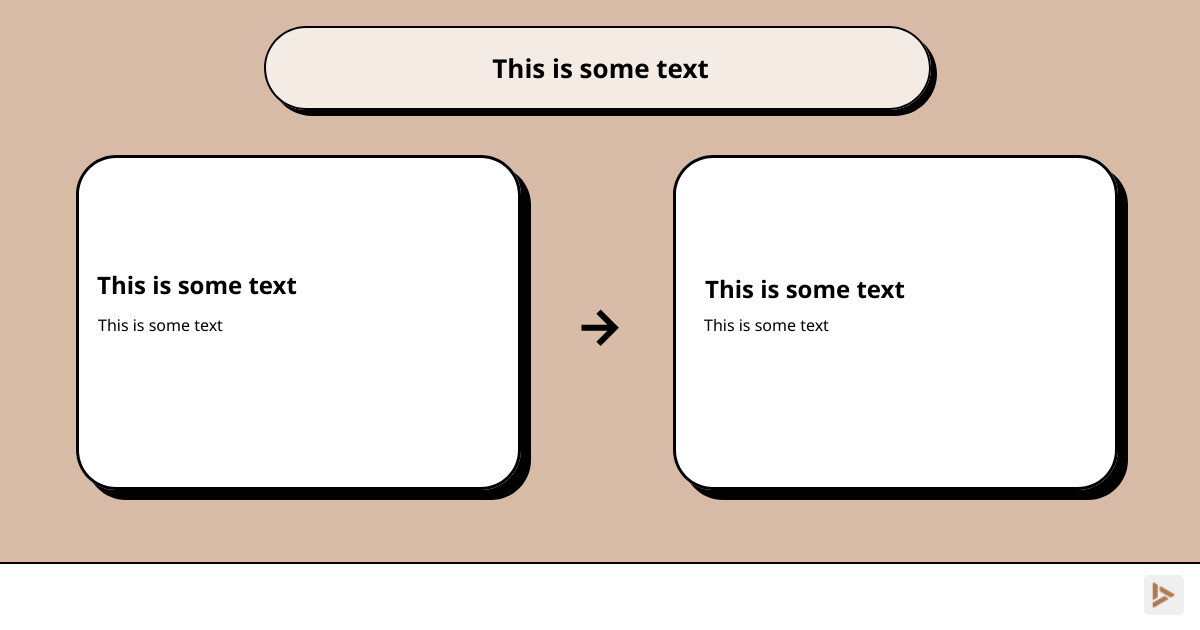User Experience Unleashed: A Comprehensive Guide to Website Redesign

When starting on a website redesign for improved ux, the primary goal is to create a seamless experience that meets user needs, improves engagement, and strengthens brand identity. A website that is visually outdated or challenging to steer can turn users away and harm a brand's reputation.
Key elements of a successful website redesign for improved ux include:
- User-Centered Design: Start by understanding your audience's needs and pain points.
- Responsive Design: Ensure your redesign works well on all devices.
- Fast Loading Times: Optimize for speed to improve user satisfaction.
- Clear Branding: Maintain consistency in messaging and visuals to build trust.
I'm Milan Kordestani, a Gen Z entrepreneur and founder of Ankord Media, where we focus on crafting digital experiences that resonate deeply with target audiences. My background in design and strategy ensures that every website redesign for improved ux is not just visually appealing but also strategically aligned with business goals.

Understanding the Need for Website Redesign
In today's digital world, a website is often the first interaction a user has with a brand. This makes it crucial for businesses to ensure their website is not only functional but also aligns with user expectations and business objectives.
User Needs
Understanding user needs is the cornerstone of any successful website redesign. Users are looking for quick access to information, smooth navigation, and an overall enjoyable experience. As noted in a UX Trends Survey, 81% of users think less of a brand if its website isn't updated. This statistic emphasizes the importance of keeping your website fresh and user-friendly.
To truly grasp what your users want, conduct thorough user research. This includes surveys, interviews, and usability testing to uncover pain points and preferences. By addressing these needs, you not only improve user satisfaction but also drive engagement and conversions.
Outdated Design
An outdated design can be a major roadblock in delivering a positive user experience. With the rapid evolution of design trends and technology, a website that looked modern a few years ago may now appear obsolete. Users expect a website to be visually appealing and easy to steer. If your website fails to meet these expectations, it can lead to a high bounce rate and lost opportunities.
A responsive design is now a necessity, not a luxury. With the increasing use of mobile devices, your website must adapt to different screen sizes and resolutions. This ensures that users have a consistent experience, whether they're on a smartphone or a desktop computer.
Business Goals
A website should not only serve users but also support the business's strategic goals. Whether it's increasing traffic, boosting conversion rates, or enhancing brand awareness, a redesign should align with these objectives.
Before starting on a redesign, clearly define what your business hopes to achieve. This could be anything from improving user retention to increasing the average order value. Having clear goals helps in measuring the success of the redesign and ensures that every design decision is purposeful.

In summary, a website redesign for improved UX is not just about aesthetics. It's about understanding user needs, updating outdated designs, and aligning with business goals to create a digital experience that resonates with your audience and drives success.
10 Steps to a Successful Website Redesign for Improved UX
Step 1: Establish Your Team
A successful website redesign for improved UX starts with assembling the right team. This team should include a UX designer, a project manager, and a content writer.
- UX Designer: Focuses on creating a user-centered design. They ensure the website meets user needs and provides an intuitive experience.
- Project Manager: Keeps the project on track, coordinating between team members and managing timelines.
- Content Writer: Crafts engaging and SEO-optimized content that aligns with user expectations and business goals.
Having a dedicated team ensures that each aspect of the redesign is handled by experts, leading to a smoother process and a better end product.
Step 2: Define Business Objectives
Before diving into design, it's crucial to define clear business objectives. What do you want to achieve with the redesign? Common goals include increasing traffic, boosting conversion rates, and enhancing user engagement.
- Traffic Increase: Aim to attract more visitors by optimizing your site's SEO and creating valuable content.
- Conversion Rates: Focus on elements like clear call-to-actions and user-friendly design to turn visitors into customers.
Setting these objectives provides direction and helps measure the success of the redesign.
Step 3: Analyze Current Website Performance
Understanding how your current website is performing is key to identifying areas for improvement. Use tools like Google Analytics to gather data on user behavior, traffic sources, and page performance.
- Usability Testing: Conduct tests with real users to gather feedback on how they interact with your site. Identify pain points and areas that need improvement.
- User Feedback: Collect feedback through surveys or interviews to understand user preferences and expectations.
This analysis provides valuable insights that guide the redesign process.
Step 4: Ideate and Create User Journeys
With insights from your analysis, start ideating solutions and creating user journeys. This involves mapping out the steps a user takes to achieve a specific goal on your site.
- Interactive Prototypes: Develop interactive prototypes that allow you to test and refine the user journey before finalizing the design. This helps identify potential issues early on and ensures a smooth user experience.
A well-thought-out user journey improves navigation and helps users find what they're looking for quickly and efficiently.
Step 5: Test and Validate Design
Once the design is ready, it's time to test and validate it. Conduct usability testing to ensure the design meets user needs and expectations.
- User Feedback: Gather feedback from users to identify any remaining issues or areas for improvement. This iterative process helps refine the design and ensures it delivers a positive user experience.
Testing and validation are crucial steps in the redesign process, ensuring that the final product is both functional and user-friendly.
By following these steps, you can create a website redesign for improved UX that not only meets user needs but also aligns with business objectives, driving success and growth.
Best Practices for Improving User Experience
Improving user experience on a website is about making it easy and enjoyable for visitors to find what they need. Let's explore some best practices: simplify navigation, intuitive design, and consistent structure.
Simplify Navigation
A website's navigation is its roadmap. If users can't find their way, they'll leave. Simplifying navigation is crucial.
- Clear Labels: Use straightforward and descriptive labels for menu items. Avoid jargon or creative names that confuse users.
- Logical Hierarchy: Organize content in a way that makes sense. Group related items together and use dropdown menus sparingly to avoid overwhelming users.
- Consistent Placement: Keep navigation elements in familiar places. Users expect to find the main menu at the top or side of a page.
HubSpot research shows that 76% of users say the most important factor in website design is the ability to find information easily.

Intuitive Design
An intuitive design feels natural. Users should know what to do without having to think too much.
- Visual Cues: Use buttons, icons, and colors to guide users. For example, a shopping cart icon indicates where to go for purchases.
- Feedback: Provide immediate feedback when users interact with elements. A simple color change on a button click lets users know their action was registered.
- Predictable Patterns: Follow common web design patterns. Users are accustomed to certain layouts and functions; deviating too much can cause confusion.
Consistent Structure
Consistency across your website builds trust and reliability. Users should feel like they're navigating a cohesive environment.
- Uniform Layouts: Keep page layouts similar. This means using the same header, footer, and sidebars across pages.
- Typography and Colors: Stick to a limited set of fonts and colors. This reinforces your brand and makes the site visually cohesive.
- Content Presentation: Present information in a consistent format. For instance, if your blog posts start with an image, keep it that way for all posts.
When navigation is simple, design is intuitive, and structure is consistent, users are more likely to have a positive experience. This not only keeps them on your site longer but also encourages them to return.
By focusing on these best practices, you can ensure your website redesign for improved UX truly improves user satisfaction and engagement.
Frequently Asked Questions about Website Redesign for Improved UX
How do I redesign my website as a UX designer?
Redesigning a website as a UX designer involves understanding your users and their needs. Start by conducting user research to uncover pain points and preferences. This helps you create a user-centered design that resonates with your audience.
Once you understand your users, focus on creating a responsive design. This ensures your site looks great on all devices, from desktops to smartphones. A seamless experience across devices is crucial as more users access websites on mobile.
Adopt a consultative approach. Work closely with stakeholders to align the redesign with business goals. This collaboration ensures the redesign meets both user needs and business objectives.
How to improve the UX of a website?
Improving a website's UX involves several key strategies. First, ensure your site is accessible to all users, including those with disabilities. Use alt text for images, provide video transcripts, and ensure keyboard navigation is possible.
Next, focus on creating a platform-independent design. This means your site should function well on various browsers and operating systems, ensuring a wide reach.
Simplify your site's navigation and ensure information is easy to find. This involves using clear labels, a logical hierarchy, and consistent placement of navigation elements.
Can a UX designer design websites?
Yes, a UX designer can design websites. While UX design focuses on user experience, it often overlaps with web design. A UX designer ensures the site is user-friendly, intuitive, and meets user needs.
UX designers are skilled in creating interactive prototypes and user journeys. They work on both the look and feel of a website, ensuring it not only looks good but functions well.
Incorporating web design principles, UX designers create layouts, choose colors, and design elements that improve usability. They ensure the design aligns with the brand and provides a seamless user experience.
By focusing on user understanding, responsive design, and accessibility, UX designers can effectively redesign websites for improved user experience.
Conclusion
At Ankord Media, we believe that a website redesign for improved UX is more than just a visual update—it's about creating meaningful digital experiences that resonate with users and drive business success.
Our approach combines strategic branding with cutting-edge design and technology. We partner with visionary clients to transform bold ideas into reality. By focusing on authentic customer connections, we craft digital experiences that not only look great but also provide exceptional functionality.
A successful website redesign starts with understanding the needs of your users and aligning those with your business goals. Our team specializes in creating user-centered designs that are responsive, fast-loading, and accessible. We ensure that every element of the site contributes to a seamless user journey.
If you're ready to lift your brand and improve your website's user experience, learn more about our services at Ankord Media.
By prioritizing user experience and strategic branding, you can create a website that not only meets but exceeds the expectations of your audience. Let's work together to turn your bold visions into tangible success.


